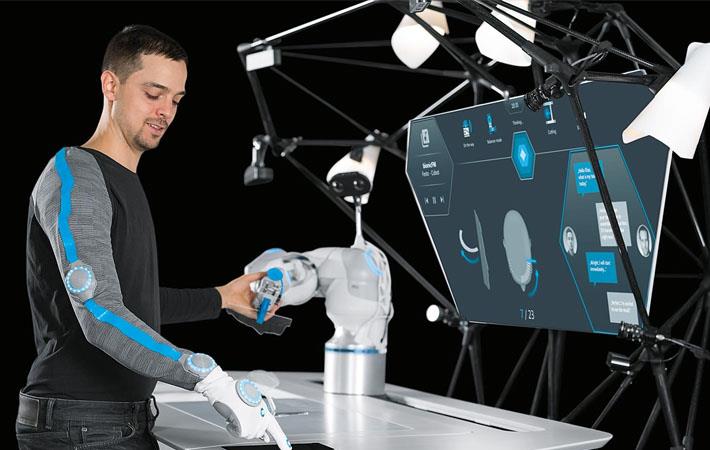Festo is showing the potential of its concept study featuring the BionicWorkplace with the BionicCobot as a solution for the textile industry at the 18th edition of ITMA exhibition. The textile and garment technology exhibition is being held from June 20-26, 2019, at Barcelona, Spain. Festo, from Germany, is a leading textile automation solutions provider.
Automation technology could bring about improvements in situations where sewing machinists receive different pieces of fabric that are unsorted. This could be particularly important given that wage developments in China may result in a shortage of workers for such tasks in the medium term, Festo said in a press release.Festo is showing the potential of its concept study featuring the BionicWorkplace with the BionicCobot as a solution for the textile industry at the 18th edition of ITMA exhibition. The textile and garment technology exhibition is being held from June 20-26, 2019, at Barcelona, Spain. Festo, from Germany, is a leading textile automation solutions provider.#
Linear and three-dimensional gantries are already at the limits of their flexibility when it comes to such tasks. The electrically operated cooperating robots used up to now are too expensive for the textile industry. The BionicWorkplace from Festo could provide a solution. Equipped with numerous sensors and the required intelligence, this concept study from Festo features the BionicCobot, a pneumatically operated cooperating robot.
Robots can be used as assistance systems to perform tasks and ease the load on people, particularly for monotonous or hazardous activities. Thanks to their natural motion pattern and the flexible pneumatic components used, bionic lightweight robots are ideal for safe collaboration between people and robots. They could represent an inexpensive alternative to classical robot concepts.
An interesting approach is a pneumatically operated cobot, which requires fewer and less expensive components than all previous electrically operated cooperating robots. The latter require a relatively expensive spindle system for each of its seven axes, including motors, spindles, frequency converters and displacement encoders. A pneumatic robot, on the other hand, requires only one rotary vane drive per axis.
The BionicCobot generates its motions using air pressure, which also makes it flexible. This enables it to interact directly and safely with people. The basis for this is digitised pneumatics. The automation platform Festo Motion Terminal VTEM controls the movements using Motion Apps. Depending on the requirements, the movements can be powerful and dynamic or sensitive and yielding so that even in the case of a collision with a person, the system does not represent any hazard. The Festo Motion Terminal combines high-precision mechanics, sensor technology as well as control and measuring technology in the tightest of spaces.
The motion patterns of the BionicCobot simulate those of the human arm, from the shoulder through to the upper arm, the elbow, the lower arm and the gripping hand. Like the blood vessels and nerve fibres in the human body, the compressed air lines run safely inside the structure and thus cannot be bent. They supply the pneumatic rotary vane drives, which are located in the seven joints of the robot arm. Also installed in each joint are two pressure sensors and an absolute encoder with CAN bus for determining the position data. This means that the BionicCobot is able, like its biological inspiration, to execute very sensitive motions.
The BionicCobot can be equipped with various grippers, depending on the application. It is operated intuitively via a specially developed graphic user interface so that users can teach-in and parameterise the required actions very easily using a tablet. The work steps can then be arranged in a timeline in any order by dragging and dropping. A complete movement sequence can be displayed virtually and simulated at the same time. The interface between the tablet and the Festo Motion Terminal is the open-source platform ROS (Robot Operating System), which is used to plan the paths of the kinematic system.
The artificial intelligence and machine learning capabilities embedded in the Festo BionicWorkplace transform workplaces into learning systems that continuously evolve and adapt to requirements. In the BionicWorkplace, people collaborate with the robot arm as well as numerous assistance systems and peripheral devices, which are networked and communicate with each other. The technology supports the workers and makes their jobs easier when carrying out strenuous or hazardous activities.
The entire workplace is ergonomically designed and can be individually adapted to people, even including the lighting. Sensors and camera systems record the positions of the worker, components and tools so that the worker can intuitively control the BionicCobot using movement, touch or speech. Software simultaneously processes all the camera images and inputs from the various peripheral devices. It uses this information to create the optimal program sequence. The system learns something new with every action solved and thus optimises itself. As a result, a controlled, programmed and set sequence gradually turns into a much freer working method. (GK)
Fibre2Fashion News Desk – India
